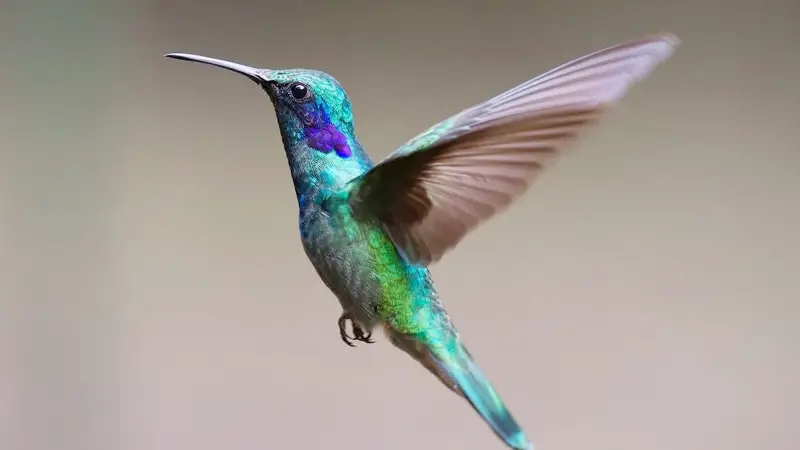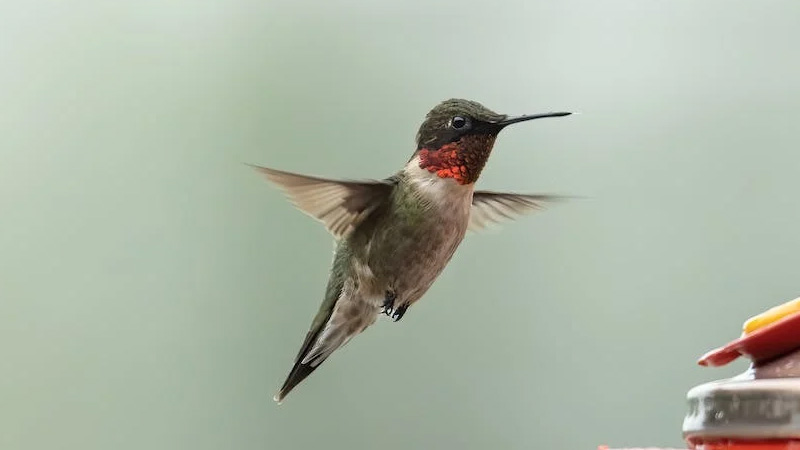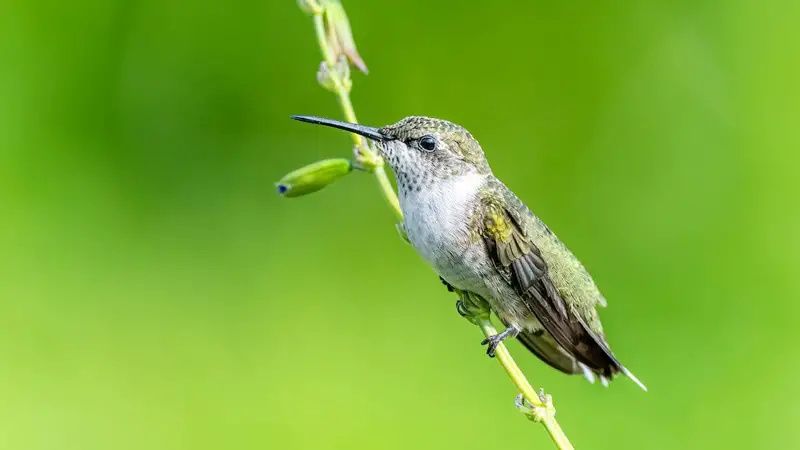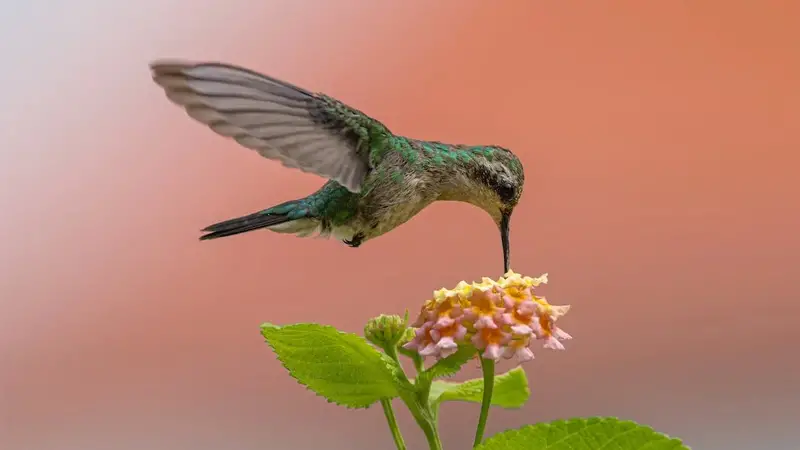Have you ever seen a hummingbird in action? These enchanting creatures with their iridescent feathers and astonishingly rapid wings are a delight to behold.
But did you know that beyond their breathtaking beauty, hummingbirds play a vital role in maintaining the delicate balance of our ecosystem?
That’s right! These tiny avian wonders are true superheroes of the natural world. So, let’s dive into the fascinating reasons why are hummingbirds important to the ecosystem.

Why Are Hummingbirds Important to the Ecosystem?
The multifaceted importance of hummingbirds in maintaining the balance and vitality of our ecosystems is as follows:
Pollination Powerhouses
First and foremost, hummingbirds are expert pollinators. While bees and butterflies often take center stage in discussions about pollination, these dainty birds are equally essential in spreading pollen from flower to flower.
As they hover effortlessly in front of blossoms, their long beaks and tongues reach deep into the nectar-filled hearts of plants. As they indulge in their sweet feast, pollen gets stuck to their feathers and beaks, which they unwittingly carry to the next flower they visit.
This magical transfer of pollen from one plant to another allows for cross-pollination, enabling plants to reproduce, diversify, and thrive.
The role hummingbirds play in pollination is particularly crucial for native plant species. Many plants have evolved specifically to attract these birds with their vividly colored flowers and sweet nectar.
In fact, some plants depend almost entirely on hummingbirds for pollination. By ensuring the survival and propagation of these plants, hummingbirds contribute to maintaining the biodiversity and resilience of our ecosystems.
Natural Pest Controllers
In addition to their role as pollinators, hummingbirds also help control insect populations. Despite their small size, these feathered dynamos are voracious predators of insects like gnats, mosquitoes, aphids, and small spiders.
By consuming large quantities of these pests, hummingbirds help keep their populations in check, which ultimately benefits gardeners, farmers, and even us humans. Just think of the fewer mosquito bites you might have to endure during those warm summer evenings!
Ecosystem Balance
Furthermore, hummingbirds serve as a vital link in the food chain. Their eggs and nestlings are a valuable source of nutrition for a variety of predators, including snakes, lizards, squirrels, and larger birds.
By providing a steady supply of food, hummingbirds support the overall health and balance of ecosystems, ensuring the survival of other species.
Seed Dispersers
Let’s not forget the role hummingbirds play in spreading seeds. Some plants have coevolved with hummingbirds to produce fruits that are irresistible to these tiny birds. As hummingbirds visit these plants to feed on nectar, they inadvertently pick up seeds on their bills and faces.
As they move from place to place, they unknowingly disperse these seeds, helping to create new habitats and expand the plant’s range.
A Source of Joy and Inspiration
Finally, the mere presence of hummingbirds in our gardens and natural spaces brings joy and wonder. Their lively acrobatics, dazzling colors, and melodious chirps captivate our hearts and inspire a sense of connection with nature.
These charismatic creatures remind us of the intricate interconnectedness of all living beings and the importance of preserving the natural world for future generations.
Are Hummingbirds Valuable to The Economy?

Hummingbirds can indeed be valuable to the economy, albeit in indirect ways. While they are not typically considered a significant contributor to the economy compared to industries like agriculture or manufacturing, they do play a role in ecological services that have economic implications.
Pollination
Hummingbirds are important pollinators for many flowering plants, especially those with tubular-shaped flowers. They have long beaks and tongues that allow them to reach the nectar deep within these flowers.
Through their feeding behavior, hummingbirds transfer pollen from one flower to another, facilitating plant reproduction. This process is crucial for the production of fruits, vegetables, and seeds.
Many agricultural crops depend on pollinators, including some that hummingbirds contribute to, such as certain types of berries, tomatoes, and peppers. The economic value of pollinators like hummingbirds can be significant in terms of crop yield and quality.
Ecotourism
Hummingbirds are charismatic and colorful birds, attracting nature enthusiasts and birdwatchers. Many people enjoy observing hummingbirds in their natural habitats, which drives ecotourism in regions where these birds are found.
Ecotourism can have economic benefits by generating revenue for local communities, and supporting small businesses such as tour operators, guides, and accommodations. The presence of hummingbirds in an area can contribute to its attractiveness as a nature tourism destination.
Biodiversity and Ecosystem Health
Hummingbirds are part of the intricate web of biodiversity, contributing to the overall health and stability of ecosystems. A diverse ecosystem with a variety of species, including hummingbirds, is more resilient and better able to withstand disturbances.
Healthy ecosystems provide various ecological services that benefit human well-being, such as water filtration, carbon sequestration, and pest control.
Protecting hummingbirds and their habitats helps maintain the overall balance and functionality of ecosystems, which can indirectly benefit economic activities reliant on ecosystem services.
It is worth noting that the economic value of hummingbirds may not be easily quantifiable in monetary terms, as their contributions are part of broader ecological systems.
Nevertheless, understanding their importance and promoting their conservation can have positive ripple effects on both the environment and certain economic activities.
Plant Species That Depend on Hummingbirds

Numerous plant species have evolved specific adaptations to attract and rely on hummingbirds for pollination.
These plants often have tubular-shaped flowers with bright colors, produce copious amounts of nectar, and are positioned at heights accessible to hummingbirds. Here are some examples of plant species that depend on hummingbirds for pollination:
Agave
Several species of agave, including Agave macroacantha and Agave stricta, rely on hummingbirds for pollination. These succulent plants produce tall flowering stalks with tubular flowers that hummingbirds can access with their long beaks.
Penstemon
Many species of penstemon, also known as beardtongues, have flowers that are perfectly suited for hummingbird pollination. Their tubular, often brightly colored flowers produce abundant nectar, attracting and benefiting from hummingbird visits.
Fuchsia
Fuchsia plants have pendulous flowers that come in various shades of red, pink, and purple. These bell-shaped flowers hold ample nectar and are well-suited for hummingbird pollination.
Cardinal Flower
The cardinal flower (Lobelia cardinalis) is a North American native plant that bears vibrant red, tubular flowers. These flowers are particularly attractive to hummingbirds, which help transfer pollen between plants.
Trumpet Vine
The trumpet vine (Campsis radicans) produces long, tubular, and orange-red flowers that are irresistible to hummingbirds. Their abundant nectar and the shape of the flowers make them ideal for hummingbird pollination.
Bee Balm
Bee balm, or Monarda, is a group of flowering plants that includes various species like Monarda didyma and Monarda fistulosa. They feature showy, tubular flowers in colors such as red, pink, and purple, which hummingbirds find appealing.
Columbine
Columbine (Aquilegia) species have unique spurred flowers with distinct shapes and color combinations. These flowers, often found in shades of red, pink, yellow, and blue, are designed to attract hummingbirds and facilitate pollination.
Sage
Several species of sage, such as Salvia coccinea and Salvia splendens, have tubular flowers that are rich in nectar and adapted for hummingbird pollination. Their bright colors and floral structure make them highly attractive to hummingbirds.
These are just a few examples of plant species that rely on hummingbirds for pollination. There are many more plant species worldwide that have developed specialized relationships with hummingbirds, highlighting the significance of these birds in plant reproduction and the maintenance of biodiversity.
What Would Happen If There Were No Hummingbirds?

If there were no hummingbirds, it would have several significant consequences for both ecosystems and certain plant species. Here are some of the potential impacts:
Reduced Pollination
Hummingbirds are efficient pollinators for many plant species, especially those with tubular flowers. Without hummingbirds, the pollination of these plants would be compromised.
This could lead to decreased fruit and seed production in various plant species, including certain agricultural crops and wild plants. The loss of hummingbird pollination could affect the availability of certain fruits, vegetables, and seeds, impacting both natural ecosystems and agricultural systems.
Plant Decline
Many plant species have co-evolved with hummingbirds and depend on them for pollination. These plants have specific adaptations to attract hummingbirds, such as tubular flowers, bright colors, and high nectar production.
In the absence of hummingbirds, these plants may face challenges in reproducing and spreading their genetic material, potentially leading to a decline in their populations.
This loss of plant diversity could disrupt the overall balance of ecosystems and affect the organisms that depend on these plants for food and habitat.
Disruption of Ecological Interactions
Hummingbirds play a role in ecological interactions beyond pollination. They are part of food chains and interact with other organisms in ecosystems.
For example, hummingbirds feed on small insects and spiders, contributing to pest control and regulating insect populations. Their absence could disrupt these predator-prey dynamics and potentially lead to imbalances in insect populations or the spread of certain pests.
Impact on Wildlife and Biodiversity
Hummingbirds are an important component of biodiversity, especially in the regions where they are native. Their absence could have cascading effects on other wildlife species that interact with or depend on hummingbirds.
For instance, certain bird species might lose a food source if their diet includes hummingbirds or their eggs. Additionally, the loss of hummingbirds could affect the availability of nectar for other nectar-feeding animals, such as bats and some insects.
Implications for Ecotourism
Hummingbirds are charismatic and attract nature enthusiasts and birdwatchers. They contribute to ecotourism in many regions where they are found.
If hummingbirds disappeared, it could impact the tourism industry, affecting local economies and communities that rely on nature tourism.
It’s important to note that the ecological impacts of losing hummingbirds would vary depending on the specific region and the interactions within the local ecosystems.
However, considering their role as pollinators, contributors to biodiversity, and participants in ecological relationships, the absence of hummingbirds would likely have far-reaching consequences for both natural ecosystems and human activities.
FAQs
To attract hummingbirds to your garden, you can take a few simple steps. First, plant a variety of flowering plants that are known to attract hummingbirds, such as trumpet vines, salvias, bee balms, and petunias. Provide a mix of colors and shapes to appeal to different species.
While sugar water is the most common and convenient food to offer hummingbirds, it’s important to note that it should be their primary source of nutrition. The sugar concentration in the solution closely resembles the nectar found in flowers.
Hummingbirds are known for their incredibly rapid wingbeats. On average, their wings beat between 50 to 80 times per second during normal flight. However, during courtship displays and high-speed flights, their wingbeats can exceed 200 times per second.
Yes, many hummingbird species are migratory. They undertake impressive long-distance journeys, some traveling thousands of miles each year. The exact migration patterns vary depending on the species and their breeding grounds.
Hummingbirds construct their nests using a variety of materials, including plant fibers, moss, lichens, feathers, and spider silk. The nests are small and cup-shaped, typically about the size of a golf ball.
Bottom Line
So, now you know why are hummingbirds important to the ecosystem. Next time you spot a hummingbird darting through your garden or hovering by a flower, take a moment to appreciate the significant role they play in maintaining the delicate balance of our ecosystem.
From pollination to pest control, seed dispersal to nurturing the food chain, these tiny guardians of nature’s harmony are true unsung heroes.
Let’s ensure we protect and preserve their habitats, so the world can continue to be graced by their presence and the magic they bring to our lives.